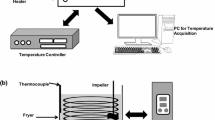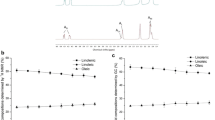Summary
The alteration of a sunflower oil used repeatedly and discontinuously for frying potatoes on 15 successive occasions was studied. For this purpose, standard analytical indexes, such as fatty acids, gas chromatography, refraction and color indexes, and acid value were compared with a chromatographic method that quantifies the polar compounds originated during fryings. Total polar content increased significantly (p<0.05) from 6.2±0.3 mg/100 mg oil to 18.7±0.8 mg/100 mg oil in the last frying. Linoleic acid decreased significantly (p<0.05) from 53.8±0.2 mg/100 mg oil to 48.1±0.8 mg/100 mg oil at the 15th frying, while oleic acid concentration remained unaltered throughout the frying operations. The color index, and acid value, showed a significant increase (p<0.05) after 15 fryings. Color index, acid value, and total polar content highly and significantly correlated with the number of fryings (0.981>r>0.933; p<0.01). Linoleic acid concentrations also significantly correlated (r=−0.692; p<0.05) with the number of fryings performed. Acid value, color index, and linoleic acid concentration also showed high and significant correlation with the percentage of total polar component of the oil (r=0.9272, r=0.9065 and r=−0.764 respectively; all p<0.01). These data suggest that standard methods such as acid value and color index can be applied and are as useful as silica-gel chromatographic evaluation in the monitoring of frying operations, provided that initial values of both the color index and acid value are available.
Zusammenfassung
Es wurden die quantitativen Veränderungen eines Sonnenblumenöls, das 15 mal aufeinanderfolgend für die Fritierung von Kartoffeln benutzt wurde, untersucht. Dazu wurden analytische Routinemethoden, wie die Gaschromatographie der Fettsäuren, die Bestimmung des Refraktions-und Farbindexes sowie der Säurezahl mit einer absorptionschromatographischen Methode zur Bestimmung der polaren Verbindungen, die während des Fritierens entstehen, verglichen. Der Gehalt polarer Verbindungen stieg signifikant (p<0,05) von 6,2±0,3 mg/100 mg Öl auf 18,7±0,8 mg/100 mg Öl bei der letzten Fritierung. Die Konzentration an Linolensäure verminderte sich dagegen signifikant (p<0,05) von 53,8±0,2 mg/100 mg Öl auf 48,1±0,8 mg/100 mg Öl beim 15. Durchgang. Der Gehalt an Ölsäure veränderte sich dagegen nicht. Der Farbindex und die Säurezahl stiegen signifikant (p<0,05) nach 15 Fritierungen. Die Veränderung des Farbindexes, der Säurezahl und des Gesamtgehalts polarer Verbindungen wiesen eine hohe und signifikante Korrelation zur Anzahl der Fritierungen auf (0,98>r>0,933; p<0,01). Der Gehalt an Linolensäure zeigte ebenfalls eine signifikante Korrelation zur Anzahl der Fritierungen (r=−0,692; p<0,05). Die Säurezahl und der Farbindex sowie der Gehalt an Linolensäure zeigten ebenfalls eine hohe und signifikante Korrelation zum Anteil der polaren Verbindungen (r=−0,9272 bzw. r=0,9065 bzw. r=−0,764; alle p<0,01). Unsere Ergebnisse zeigen, daß Routinemethoden, wie Säurezahl oder Farbindex, die wir für die Bestimmungen im Sonnenblumenöl benutzt haben, genauso nützlich sein können wie andere mehr spezifische Methoden, wenn man die Ausgangswerte dieser Indizes für das zu behandelnde Öl hat.
Similar content being viewed by others
References
Bender A (1978) Food processing and nutrition. Academic Press, London, pp 82–83
Billek G (1985) Heated fats in the diet. In: Padley FB, Podmore U (eds) The role of fats in human nutrition. Ellis Horwood Ltd, Chichester (England), pp 163–171
Blumenthal MM (1991) A new look at the chemistry and physic of deep-fat-frying. Food Technol 45:68–71
Coll-Hellín L, Rueda MP (1984) Incidencias de la fritura en la composición de la fracción lipídica de diversos aperitivos de consumo generalizado en nuestro país. Anal Bromatol 36:33–60
Cuesta C, Sánchez-Muniz FJ, Rodríguez A, Varela G (1987) Alteraciones fisicoquímicas de un aceite de oliva empleado en frituras repetidas y su incidencia sobre la lipoproteinemia de ratas. Rev esp Fisiol 13:51–56
Cuesta C, Sánchez-Muniz FJ, Hernández I (1991) Evaluation of nonpolar methyl esters by column and gas chromatography for the assessment of used frying olive oils. J Am Oil Chem Soc 68:443–445
Cuesta C, Sánchez-Muniz FJ, Hernández I, López-Varela S (1991) Modificaciones de un aceite de oliva durante las frituras sucesivas de patatas. Correlaciones entre distintos índices analíticos y de evaluación global de la degradación. Rev Agroquim Tecnol Aliment 31:523–531
Dobarganes MC, Pérez-Camino MC, Márquez-Ruiz G (1989) Determinación de compuestos polares en aceites y grasas de frituras. Grasas y Aceites 40:35–38
Domenech JM (1982) Bioestadística. Métodos estadísticos para investigadores (4th edition). Herder, Barcelona, pp 337–341
El-Zeany BA, Abdel Fattah LC (1982) Reacción de oscurecimiento en lípidos-proteínas oxidados. Parte 6. Oscurecimiento producido por las interacciones de ácidos grasos libres con proteínas. Grasas y Aceites 33:216–219
Frankell EN (1991) Review. Recent advances in lipid oxidation. J Sci Food Agric 54:495–511
Fritsch CW (1981) A brief review. J Am Oil Chem Soc 58:272–274
Guillaumin R (1988) Kinetics of fat penetration in food. In: Varela G, Bender AE, Morton ID (eds) Frying of food. Principles, changes, new approaches. Ellis Horwood Ltd, Chichester (England), pp 82–90
Gutiérrez González-Quijano R, Dobarganes MC (1988) Analytical procedures of the evaluation of used frying fats. In: Varela G, Bender AE, Morton ID (eds) Frying of food. Principles, changes, new approaches. Ellis Horwood Ltd, Chichester (England), pp 141–154
Hernández I, Sánchez-Muniz FJ, Cuesta C (1989) Evaluación de la termoxidación de un aceite de oliva empleado en frituras de patatas. Correlaciones entre las fracciones no alteradas de triglicéridos y ésteres metílicos. Grasas y Aceites 40:257–263
Metcalfe LV, Schmitz AA, Pelka JR (1966) Rapid preparation of fatty acid esters from lipids for gas chromatographic analysis. Anal Chem 38:514–515
Moreiras-Tuni O, Carbajal A, Perez del Pino IM (1990) Evolución de los hábitos alimentarios en España. Ministerio de Sanidad y Consumo. Secretaría General Técnica. Artes Gráficas Iberoamericanas SA Madrid, pp 103–108
Pérez Camino MC, Márquez-Ruiz G, Salgado Raposo A, Dobarganes MC (1988) Alteración de grasas utilizadas en frituras. III. Correlación entre índices analíticos y métodos de evaluación directa de compuestos de degradación. Grasas y Aceites 39:72–76
Presidencia del Gobierno (1989) Norma de calidad para los aceites y grasas calentadas. Boletín Oficial del Estado. 31 de Enero de 1989. Madrid
Prevot A, Desborden S, Morin O, Mordret F (1988) Volatiles and sensory effects from frying oils. In: Varela G, Bender AE, Morton ID (eds) Frying of food. Principles, changes, new approaches. Ellis Horwood Ltd, Chichester (England), pp 155–165
Sánchez-Muniz FJ, Hernández I, Cuesta C (1989) Estudio de la calidad del aceite extraido de patatas fritas en aceite de oliva. Grasas y Aceites 40:399–405
UNE 55015 (1958) Materias grasas. Indice de refracción. Instituto Nacional de Racionalización del Trabajo, Madrid
UNE 55011 (1964) Materias grasas. Determinación de los ácidos libres. Instituto Nacional de Racionalización y Normalización, Madrid
Varela G, Moreiras-Varela O, Ruiz-Roso B (1983) Utilización de algunos aceites en frituras repetidas. Cambios en las grasas y análisis sensoriales de los alimentos. Grasas y Aceites 34:101–107
Waltking AE, Wessels H (1981) Chromatographic separation of polar and non-polar components of frying fats. J Assoc Off Chem 64:1329–1330
Wolff JP (1968) Manual d'Analyse des Corps Gras. Asuolay, Paris
Author information
Authors and Affiliations
Rights and permissions
About this article
Cite this article
Sánchez-Muniz, F.J., Cuesta, C. & Garrido-Polonio, M.C. Evaluation of a sunflower oil used for frying by different analytical indexes and column and gas chromatography. Z Ernährungswiss 33, 16–23 (1994). https://doi.org/10.1007/BF01610575
Received:
Accepted:
Published:
Issue Date:
DOI: https://doi.org/10.1007/BF01610575




